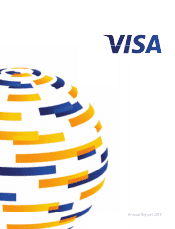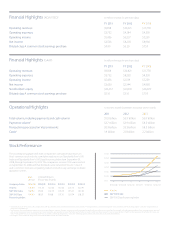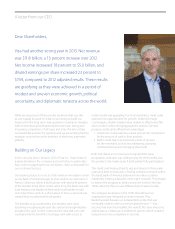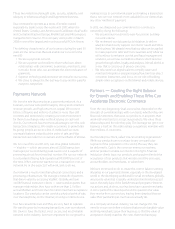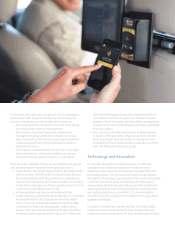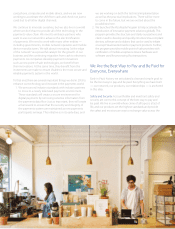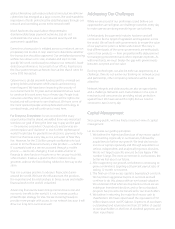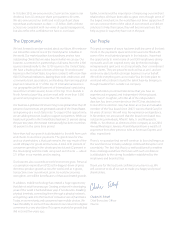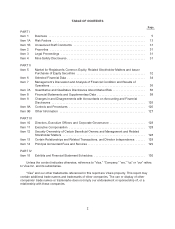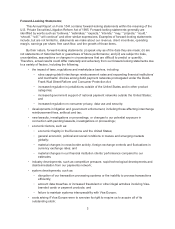Visa 2013 Annual Report Download - page 7
Download and view the complete annual report
Please find page 7 of the 2013 Visa annual report below. You can navigate through the pages in the report by either clicking on the pages listed below, or by using the keyword search tool below to find specific information within the annual report.globe. Eliminating cash reduces physical crime, but we all know
cybercrime has emerged as a large concern. We understand the
importance of both protecting the data that passes through our
network and controlling access to the network itself.
Much has been discussed about the potential to
disintermediate large payment networks, but do not
underestimate the value of our network security and risk
assessment capabilities.
Every time a transaction is initiated across our network, we run
proprietary risk models in near real time to determine whether
the transaction should be approved. Our centralized processing
architecture allows us to scan, evaluate and react to risks
quickly. We work continuously to enhance our network’s fraud-
detection performance. As a result of our efforts, fraud across
the Visa system remains at historic lows at less than 6 cents for
every $100 transacted.
Cybercrime is global and well-funded, and the criminals are
getting bolder and smarter, while attacks are becoming
more frequent. We have been improving the security of
our environment for 50 years and understand that we need
to continue this work every hour of every day. People trust
networks until they don’t, and we’ve earned the right to be
trusted and will continue to earn that trust. We have some of
the most talented people and sophisticated technology to
combat threats, and will continue to invest here.
For Everyone, Everywhere: As we considered the many
opportunities that lie ahead, we added three very important
words to our goal of being the best way to pay and be paid
— for everyone, everywhere. Our products and services are
commonplace and “dial tone” in much of the sophisticated
world. People take for granted how electronic payments help
them live their lives every day, as it is just a part of how they
live. However, for the 2.5 billion people worldwide who lack
access to formal financial services, a Visa product — whether
it’s a prepaid card or a service accessed through a mobile
phone — can be life-changing. It can enable a farmer in
Rwanda to store funds on his phone so he can pay his child’s
school tuition. It allows a grandmother in Mexico to buy
groceries without the fear of being robbed on her way to the
store.
Visa is in a unique position to advance financial inclusion
around the world. We have the infrastructure, the products,
the expertise and the relationships to bring secure and reliable
financial tools to the world’s unbanked.
Advancing financial inclusion brings tremendous social and
economic benefit to the world. It is not, however, purely a
philanthropic strategy for Visa. We are investing heavily to
provide more people with access to our network because it will
drive our long-term success as well.
Addressing Our Challenges
While we are proud of our performance and believe our
opportunities are still great, we challenge ourselves every day
to make sure we are doing everything we can to thrive.
Unfortunately, the payments industry has been and will
continue to be the target of legislation and regulation across
the world. We will work with governments to ensure the value
of our payments system is better understood. The irony is
that different parts of the same governments are enthusiastic
users of our products — from prepaid benefits disbursement
to managing procurement and other corporate expenses. As
with merchants, we must bridge the gap with governments
between our price and our value.
Evolving technologies can also be either an opportunity or a
challenge. If we do not evolve our thinking on network access
and partnership, other competing networks will be more
attractive.
Network integrity and data security are also an opportunity
and a challenge. Networks earn trusted status in the eyes of
merchants and consumers by providing robust protection
against fraud. We have earned this right, but we need to
continue to earn it every day.
Capital Management
Since going public, we have had a consistent view of capital
management.
Let me review our guiding principles:
1. We believe the highest and best use of our excess capital
is reinvesting organically in our business, followed by
acquisitions to further our growth. We treat decisions to
invest our capital organically and through acquisitions as
serious, independent, and analytically rigorous decisions.
We do not target a specific amount but are happy if the
number is large. The more we reinvest in our business, the
better we feel about our future.
2. After supporting our growth, we believe in continuing to
grow our dividend, targeting a 20 percent payout ratio of
trailing 12-month net income.
3. The final use of our excess capital is buying back our stock.
We have been aggressive buyers of our stock and will
continue to do this, always with an eye toward valuation.
We understand that when we buy back our stock we are
making an investment decision, and so far our buyback
program has proved to be beneficial for our shareholders.
4. We believe in returning the majority of excess cash to
shareholders. We have repurchased the equivalent of 151
million shares since our IPO (about 20 percent of our shares
outstanding) and returned more than $17 billion of capital
to our shareholders in the form of dividend payments and
share repurchases.

